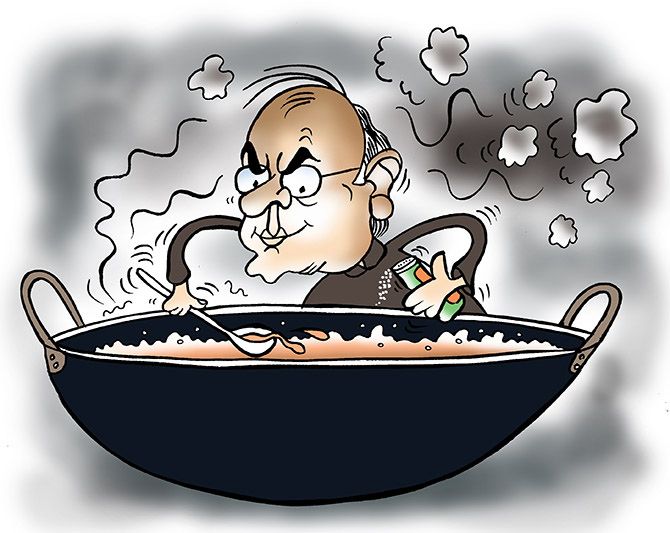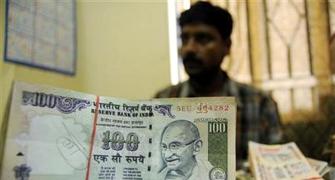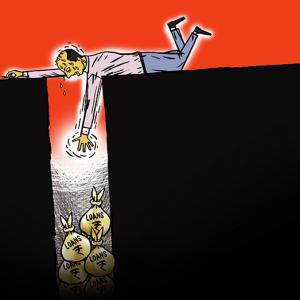Without bringing sound governance and technical capabilities into the RBI's work, injecting new money sets the stage for a next wave of bad behaviour by banks, warns Ajay Shah.

Rs 1.35 trillion: This is a large sum of money.
Rs 1.35 trillion is 11 per cent of the net tax revenue of the Union government this year, and 100 per cent of the value for 2002-2003.
The first three phases of the Delhi Metro added up to Rs 0.7 trillion: This decision spends twice this money.
The problems of Indian banking will not end here.
Economic policymakers will be posed with very big decisions on fiscal expenditures to bail out banks in the future also.
What are the principles which help us in making these decisions?
The first question that we should ask is: How badly does India need banking?
There are other countries (the US, the UK, Japan, China) where the banking system is quite large. But in India, banks do not matter that much to the economy: We are a market-dominated economy.
The 2,400 large companies alone have equity market capitalisation of Rs 131 trillion. If we were able to count the value of equity in the remaining firms, it would add up to a lot more.
In contrast, the credit by all banks to all private persons (summing up across firms and individuals) stands at Rs 80 trillion.
Banking is less important to India than is the case elsewhere.
The second question that we should ask is: Do we have policy levers through which the flow of capital through non-bank channels into the economy can be sharply augmented?
In our case, the answer is clearly 'yes'. A great deal is easily done by way of liberalising the equity market, the bond market, foreign capital inflows, NBFCs, fintech, securitisation, etc.
By pressing those levers, we can increase access to capital, and counteract the long winter of bank lending.
The third question that we should ask is: Is the economy at a time when it makes sense for borrowing to rise?
In India today, we are at a momentous change with the implementation of the Insolvency and Bankruptcy Code.
Corporations in India have traditionally been undisciplined and habitually delayed payments. The IBC has empowered a single aggrieved operational creditor or lender or bondholder to initiate the bankruptcy process.
Indian firms now need to up their game: They need to run a tight ship and make all payments on time. This will require reducing leverage.
A decline in leverage for a few years is appropriate, and was going to come about even if there was no banking crisis.
The fourth question that we should ask is: Do we have the fiscal soundness through which increased borrowings can be smoothly achieved?
The answer in India is in the negative. India has chronic fiscal stress and a weak credit rating, and does not have voluntary bond investors who trust Indian fiscal institutions.
Increased indebtedness will not be placidly absorbed, and large increases of debt are unfeasible.
The fifth question that we should ask is: What is the social cost of the last rupee of government expenditure?
In a country with a sound framework for tax policy and tax administration, and with sound techniques in public debt management, the cost to society of an additional Rs 1 of government expenditure proves to be between Rs 1.3 and Rs 1.5.
But in India, given the infirmities of tax policy, tax administration, and debt management, the last additional rupee of government spending comes at a higher cost to society. We estimate this at Rs 3 (external link).
This means that the decision to spend Rs 1.35 trillion imposes a cost upon society of Rs 4 trillion.
We should be stubbornly frugal with public money in India.
The sixth question we should ask is: Why did things go wrong, and are we ensuring they will not go wrong again?
In the case of the banking crisis, this requires bringing sound governance and technical capabilities into the RBI's work on banking regulation and supervision.
If this is not done, injecting new money merely sets the stage for a next wave of bad behaviour by banks.
It was striking to see the stock market respond to the ministry of finance decision with a higher stock price for construction companies and ICICI Bank.
Every discussion on spending taxpayer resources for banks should go with the associated white paper on RBI reforms.
This requires intellectual capabilities -- merging two weak public sector banks to make a big weak public sector bank does not help.
Some people are enthusiastic about the 'big bazookas' which were used by the UK and the US treasuries in the 2008 crisis. It has been suggested that it is a moral obligation for India to put such vast fiscal resources to work for Indian banks.
However, the answers to the six questions, in the US or the UK, were very different. They had big banking systems. They had no headroom to liberalise and thus augment non-bank finance. They were also in a phase where de-leveraging was required.
They had AAA credit ratings, sound public debt management, and could surge debt. Their marginal cost of public funds was about 1.5, reflecting sound frameworks for tax policy, tax administration, and debt management.
Their ministries of finance did not merely put up money; they reformed their financial agencies with a vengeance.
Deep experiential local knowledge is supremely important in fields like economics.
Look back at the UTI crisis.
While taxpayer money was used, this was accompanied by deeper reforms: The UTI Act was repealed, the privatisation process for UTI was begun, and UTI was placed under the regulation of the Securities and Exchange Board of India.
The key persons (Yashwant Sinha, S Narayan, Jaimini Bhagwati, P Chidambaram, U K Sinha, K P Krishnan, M Damodaran) pushed reforms alongside taxpayer money.
That episode was harder as policymakers had to figure out the steps on the fly.
In contrast, today, mature design work of financial sector reforms is at hand, which reduces policy risk.
Ajay Shah is a professor at the National Institute of Public Finance and Policy, New Delhi.









